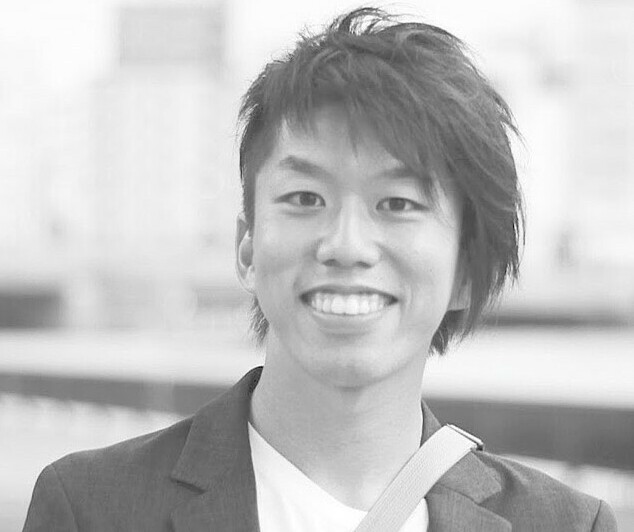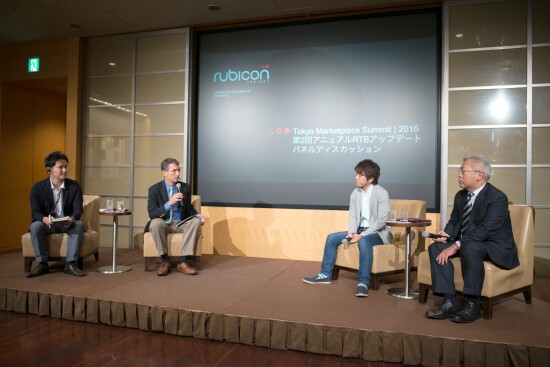Q&A: Hakuhodo’s D.A.Consortium on Automation, Programmatic and TV

Second of a two-part series! Jay Sears, Senior Vice President Marketplace Development of Rubicon Project discusses “Automation, Programmatic and TV” with Kent Isshiki of Hakuhodo’s D.A.Consortium. The two executives appeared at Rubicon Project’s The 2nd Annual Real Time Trading Update from Japan's Buy Side in July 2015.

(Pictured left to right: Kei Iwashima, Sales Manager, Buyer Cloud, Rubicon Project; Jay Sears, Kent Isshiki, Strategic Planning Expert, Global Business Group, Hakuhodo’s D.A.Consortium, and Yoshihiko Miyaichi, IT Project Manager, Dentsu Digital Holdings, Inc. at the Rubicon Project Tokyo Marketplace Summit.)
Be sure to read Sears' interview with Yoshihiko Miyaichi of Dentsu Digital Holdings, Inc.
Your Name:Kent Isshiki
Your Company:D.A.Consortium Inc.
Your Title:Strategic Planning Expert, Global Business Group
SEARS: What do you read to keep up with politics, art and culture?
ISSHIKI:Yahoo! Japan news, Hatena, Feedly
SEARS: What do you read to keep up with friends?
ISSHIKI: Facebook
SEARS: What do you read to keep up with our industry?
ISSHIKI:Facebook and Feedly
SEARS: What’s your favorite commercial of all time?
ISSHIKI: Bell's Whisky -- The Reader
SEARS: With regards to advertising automation and programmatic, what are DAC’s three biggest initiatives in Japan in 2015?
ISSHIKI:
- Balance.
- Data.
- Technology.
One of our initiatives is balance. We handle premium and trading campaign and operation almost equally. Only trading cannot be sufficient for branding sometimes. Only premium cannot be sufficient for performance. But sometimes premium performs better than trading in terms of reach or branding, and sometimes even performance also. We’re utilizing both with balance to achieve client KPI. To achieve well, we’re enhancing our unique data and technology.
SEARS: On average company-wide across Japan, out of each $1.00 spent on media (all media, not just digital) by one of your advertisers how much today (in 2015) is spent on automated or programmatic channels?
ISSHIKI:Now digital media spent is around 15% of the total advertising market in Japan. And 40-50% of it is spent to programmatic channels. So maybe I can say it’s around $0.07.
SEARS: What will this number be in 2017?
ISSHIKI: $0.15 hopefully. Need time.
SEARS: Tell us the about the Japanese operations of DAC.
ISSHIKI:DAC is one of the largest digital ad agencies (media-rep) in Japan and was established by a consortium of leading ad agencies headed by Hakuhodo. DAC delivers innovative services in the areas digital advertising planning, consulting, ad technology and operational support to Japan’s leading online publishers and advertisers.
SEARS: Please tell us:
- SEARS:Percentage increase, managed budget (media spend) 2014 vs. expected 2015:
- ISSHIKI:20%.
- SEARS:How many employees are there in your organization?
- ISSHIKI:As a DAC Group, around 2,000 in total.
SEARS: Draw an analogy between the automation of television and a baseball game. Are we in the pre-game? Still driving to the stadium?
ISSHIKI: In Japan, I think it’s in a stage that the baseball team owners are wondering whether they should open this game or not. I think the situation and structure of the TV market is much different between the United States and Japan in terms of reach and efficiency, content holder and broadcaster, connection percentage and user generation. Thus, there might not be a serious reason for Japanese TV companies to do automatic or programmatic.
SEARS: How can advertising automation help the strategy and planning functions (directly or indirectly) at an advertising agency?
ISSHIKI:Automation can bring operational efficiency and people can spend more time on strategy and planning. But one critical challenge for this is whether we can consolidate media buying and also data. Realistically, I believe it’s same in the US, though there are gigantic platforms such as Google, Facebook, Twitter, Yahoo, etc. When we think of overall media buying, we cannot forget or avoid these players. If someone ignore these players, the business cannot scale. These players are providing some APIs though, if you try to support all, it’s always really fragmented. So, unless this kind of critical consolidation and integration issue isn’t solved, the automation business cannot have real scale and business.
SEARS: Can linear TV be automated, yes or no?
ISSHIKI: Technically yes, anything can be automated. But we have to consider the uniqueness of the Japanese TV market if we want to make it happen. One stats says that the number of advertisers who’re running TVCF in the whole country is less than 500. Do you see a big opportunity for automation only for this number of advertisers? Also, there are around 100 local TV stations, though basically they’re all under the key five group companies and each local station has only a limited number of local clients.
SEARS: Transparency -- on media costs, on data, on inventory -- has become a lightning rod issue. Should transparency be a negotiated benefit for the advertiser client, yes or no?
ISSHIKI: In Japan, basically all media transactions are margin business even for trading type of business. In this sense, basically it’s already transparent and it should be.
SEARS: Which of the following will accelerate the automation of site direct (direct orders) budget? Pick all that apply:
- Dynamic access to all publisher inventory [vs. just “remnant” or “auction”]
- Ability to leverage publisher first party data
- Ability to leverage advertiser first party data [against all publisher inventory, especially premium]
- Availability of rich media, expandable units and larger IAB Rising Star formats
- Ability to more easily curate audiences for specific advertisers across the premium content of multiple publishers
- All of the above
ISSHIKI:F. All of the above helps the adoption. Without all of these, it cannot be a real scalable business.
SEARS: If you could go to the airport right now with friends or family and fly anywhere in the world for vacation, who would you take and where would you go?
ISSHIKI:Exuma, Bahamas with my fiancée. Can you imagine? There’s a beach that you can swim with wild pigs!
SEARS: If you could create an endowment to fund any existing non-profit you designated, what lucky non-profit organization would that be?
ISSHIKI: A non-profit organization for sick children.
SEARS: What is your favorite restaurant in the world?
ISSHIKI: Sharaku in Kamakura, Japan. It’s my favorite restaurant in the world and is located near my house.
SEARS: Thanks, Kent-san!
The opinions and points of view expressed in this commentary are exclusively the views of the author and do not necessarily represent the views of MediaVillage/MyersBizNet management or associated bloggers.


